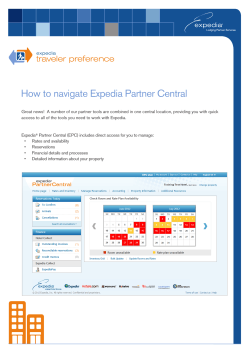
What is EPC?
RFID systems SIMATIC RF:
What is EPC?
The latest generation of RFID components from
Siemens, the SIMATIC RF660 Portal Readers, now also
support the GEN-2 EPC standard. EPC stands for Electronic Product Code – but what does it actually mean?
EPC is synonymous with a new level of development in the
field of RFID systems: spectacularly inexpensive tags (price <
0.15 EUR for large quantities), excellent performance data
and worldwide standardization of the protocols and applications are enabling new applications for RFID in intralogistics,
supply chain management and trade. The Electronic Product
Code (EPC) itself is only one part among a large number of activities and technologies.
EPC is the brainchild of EPCglobal, located in the U.S. EPCglobal mainly consists of a series of bodies which promote and
lend impetus to the development and standardization of all
the technologies needed for RFID in logistics and trade. All
well-known manufacturers of RFID systems, including the
large software companies, and many RFID users (e.g. METRO
or Walmart), are members of EPCglobal. Apart from technical
standardization, there are so-called "Business Action Groups",
which deal with the use of EPC in different branches of industry.
EPCglobal is sponsored by GS1 International and its national
off-shoots. The main task of GS1 is the administration and allocation of internationally used numbering systems such as
the European Article Number (EAN). Companies which want
to introduce such numbering systems must obtain a license
from GS1 for a specific range of numbers. GS1 also participates in projects for the further integration (of data) in trade,
e.g. through the ECR Initiative. The ranges of EPC numbers are
allocated by GS1.
For manufacturers of RFID systems, the radio standards of
EPCglobal are extremely important. In this context, a series of
RFID technologies are defined which were once based on proposals by members but are now being developed by EPCglobal's own special action groups. EPC divides the tag specifications and the standards for the air interface into different
classes:
SIMATIC Sensors
RFID Systems SIMATIC RF
■ CLASS 0: passive, read-only tags (programming is carried
out by the semiconductor manufacturer)
■ CLASS 1: passive tags which can only be written once
■ CLASS 1 GENERATION 2: passive tag which can be written
several times
■ CLASS 2...4: other definitions for semiactive and active
systems
Tags of CLASS 1 GENERATION 2 (usually abbreviated to
GEN-2) are the most important data carriers. This standard
has contributed to a considerable increase in the recognition
rate and reading speed. In addition, the multi-tag reading capability (several tags are in the field at the same time) has
been improved and can cope with over 100 tags simultaneously.
Fig. 1: GEN-2 inlay from Texas Instruments. This inlay is attached to the paper
label to form the RFID label i.e. the tag.
In the past, EPCglobal had only used the UHF band but this
band cannot be used worldwide on a
In the U.S., the frequenuniform frequency. The UHF frequencies 902…928 MHz and
cies are also used for cell phone, miliin Europe, the frequentary and civil radio applications as well cies 865…868 MHz
have been released for
as for short range devices (e.g. babyRFID. In Asia, in conphones). Therefore, there are consider- trast, there are other
regulations.
able differences in regional and national implementation.
s
Which standards are supported by SIMATIC RF600?
The SIMATIC RF660R Portal Reader implements the EPC
standards CLASS 1 and CLASS 1 GEN-2. In addition, the
reader supports the ISO 18000-6B protocol which is mainly
used in Europe and, in addition to other applications, is
used by Philips in its UCODE products.
The reader has been certified for applications in the U.S. (in
accordance with FCC, 915 MHz) and Europe (in accordance
with ETSI, 865 MHz).
The current GEN-2 tags can be used in all internationally
released frequencies. Therefore, there are no longer any reasons why it should not be introduced in international logistic
chains. Readers and antennas, however, must still comply
with national regulations.
Adherence to the standards is an important prerequisite for
the creation of inter-company logistics systems which are currently being planned in business today. For this reason, EPCGlobal maintains its own certification and accreditation offices, where RFID system components (i.e. tags and readers)
are certified independently according to EPC standards. These
test series include e.g. the "hardware compliance test", in
which RFID readers are examined. In addition, EPCglobal
issues accreditation to test laboratories which, for example,
investigate the way in which tags work and their optimum
positioning on the case or pallet ("sweet spot"). In Germany,
EECC is the first laboratory which has received an EPCglobal
accreditation.
Another element is the EPC itself, i.e. the Electronic Product
Code. This EPC is part of the data format on the chip of the
RFID tag. The EPC is mainly designed for storing manufacturer
and product IDs as well as a serial number. In this combination, the EPC is interpreted as a serial global trade item number (SGTIN, corresponds to the European EAN + serial number).
Electronic Product Code-96
dataheader
EPC manager
object class
serial number
8 bit
28 bit
24 bit
36 bit
Fig. 2: The EPC code in the form of a 96-bit SGTIN. The "EPC Manager" is the
manufacturer of the product.
However, there are no current plans to introduce EPC in trade
and therefore EPCglobal has defined algorithms for converting many other coding schemes. The latter include, for example, the Serial Shipping Container Code (SSCC, also know as
the "number of the dispatch unit" = "Nummer der Versandeinheit" NVE in Germany) and the Serial Global Location Number
(SGLN), which now also enables identification of locations
(e.g. storage locations) within a company.
Usually, the EPC is 96 bits long. The first 8 bits in the dataheader define the length and format of the subsequent code.
In order to use the memory reserved for the actual EPC for the
company's own data, the datahead must be coded correctly as
"proprietary". In the case of a 96-bit EPC, therefore, there are
only 88 bits available for the company's own use. Apart from
such data, GEN-2 tags can also store user data. The size of this
user memory depends on the manufacturer; the formatting is
still in the process of being standardized.
RFID Systems SIMATIC RF
Finally, EPCglobal is also participating in the definition of
future software structures. EPC has proposed that product
manufacturers install so-called "information servers" (EPC IS).
These are databases which provide further information on
each product type or, on the basis of the serial number, on
each individual product, e.g. product characteristics, certifications, use-by date etc.
In order to track down the relevant database, an "Object Name
Service" (EPC ONS) converts the manufacturer ID stored in the
EPC into a web address. These ONS servers work analogously
to the Domain Name Services used in the Internet.
Object Name Service
Request from
Internet
EPC Information Service
Networked database
Application Level Events
Filter Middleware
Companyinternal
database
Reading Protocol
RFID devices
Fig. 3: EPC software architecture (simplified)
EPCglobal only defines roles and interfaces for individual components. These modules are implemented and sold by major
software companies (e.g. Oracle).
In practice, the interfaces for linking up the RFID devices (reading protocol) as well as the functions and interfaces of the
RFID filter middleware (Application Level Events) have been
implemented specifically for manufacturers. However, in the
case of the filter middleware, there is an additional number of
concurrent concepts and products (e.g. from SAP, IBM, Microsoft). However, it is not yet clear which architecture will
prove itself as the leading solution. Other software levels of
the EPC architecture, in contrast, are not very important since
they are still in the development stage.
More information in the internet:
www.siemens.com/simatic-sensor s/r f
Author:
Markus Weinländer
E-Mail: markus.weinlaender@siemens.com
Provided by
Siemens AG
Automation and Drives
Factory Automations Sensors
Postfach 48 48
90327 NÜRNBERG
GERMANY
The information provided in this brochure contains descriptions or characteristics of performance which in case of actual use do not always apply as
described or which may change as a result of further development of the
products. The desired performance features are only binding if expressly
agreed upon in the contract. Delivery options and technical data subject to
change without prior notice.
SIMATIC Sensors
© Siemens AG 2006
2
© Copyright 2025


















